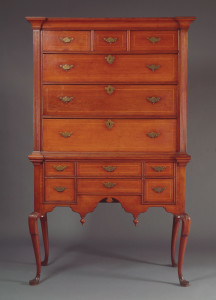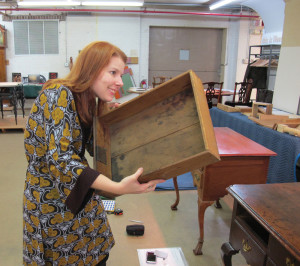New Jersey-made Furniture: Fact or Fiction?
EMERGING SCHOLARS > SUMMER RESEARCH GRANTS
By Jackie Killian
The title of this article is a question that I asked myself when deciding on a thesis topic last spring. Numerous documented examples of furniture made during the first fifty years of colonial settlement in the Lower Delaware River Valley exist, and I am fortunate that so many are in Winterthur Museum’s collections. Signatures of their makers tie them to production in Philadelphia or within the original sprawling boundaries of Chester County, Pennsylvania. With one or two notable exceptions in public collections, however, furniture produced definitively within the colony is unknown. Documentary evidence shows a vibrant community of carpenters, joiners, and cabinetmakers active in Burlington and Salem, New Jersey in the early period of the colony. But where is their furniture?
I use casework – chests of drawers, dressing tables, and high chests primarily – as my material evidence. Case pieces are complex objects made of a variety of woods, employ a number of construction techniques, and have broad surfaces on which the marks of cabinetmakers or owners can be written. In my research I fully examine each piece – cataloguing its dimensions, construction, and markings – with the goal of establishing a construction profile for furniture made in the Delaware Valley prior to 1740. I identified over twenty-five public and private collections that are repositories of this furniture, which meant there was (and still is!) a lot of traveling in my future. With a generous Summer Research grant from the Decorative Arts Trust, I examined furniture at the most distant collections: Colonial Williamsburg, Yale University Art Gallery, the Metropolitan Museum of Art, and the Newark Museum.
My furniture examinations were all exciting: each object and its construction imparted a piece of new knowledge and nuanced my understanding of cabinetmaking practice in this region. In addition to that, wonderful moments of discovery were shared along side museum curators whose insights informed my thinking about the objects, and my research. A mid-eighteenth century walnut high chest at the Newark Museum was especially interesting. Originally owned by a native of Maidenhead (now Lawrenceville), NJ, the two-part joined case was constructed in a way that was standard for the period, but its secondary wood of sweet gum was unique compared to all other furniture I had examined. It was a sophisticated piece with its paneled ends, hollow double-bead applied molding, and projecting pilasters – fluted on the side and rear faces. The timid carving of the cabriole legs was the only thing out of place. Was this the work of a skilled craftsman, perhaps a house carpenter, who had the practical knowledge and tools to make the case and its refined decoration, but was not specially trained in carving? Further research of this piece and craftsmen active in this area will hopefully answer that question. I am grateful to the DAT’s members for supporting my scholarship with this opportunity, and to Ulysses Dietz, Tara Gleason Chicirda, Patricia Kane, Jennifer Johnson, Eric Litke, Peter Kenny and Nicholas Vincent for giving so generously of their time.
SAVE THE DATE
- Special Symposium
“Classical Splendor”
The Philadelphia Museum of Art
November 4, 2016 - New York Antiques Weekend
January 20-21, 2017 - Spring Symposium
Savannah
April 21-24, 2017 - Spring Study Trip Abroad
Scotland
May 14-22, 2017 - Fall Symposium
Hartford & Western Connecticut
September 2017 - Fall Study Trip Abroad
Venice and the Veneto
October 9-16 and 22-29, 2017
By Jackie Killian
The title of this article is a question that I asked myself when deciding on a thesis topic last spring. Numerous documented examples of furniture made during the first fifty years of colonial settlement in the Lower Delaware River Valley exist, and I am fortunate that so many are in Winterthur Museum’s collections. Signatures of their makers tie them to production in Philadelphia or within the original sprawling boundaries of Chester County, Pennsylvania. With one or two notable exceptions in public collections, however, furniture produced definitively within the colony is unknown. Documentary evidence shows a vibrant community of carpenters, joiners, and cabinetmakers active in Burlington and Salem, New Jersey in the early period of the colony. But where is their furniture?
I use casework – chests of drawers, dressing tables, and high chests primarily – as my material evidence. Case pieces are complex objects made of a variety of woods, employ a number of construction techniques, and have broad surfaces on which the marks of cabinetmakers or owners can be written. In my research I fully examine each piece – cataloguing its dimensions, construction, and markings – with the goal of establishing a construction profile for furniture made in the Delaware Valley prior to 1740. I identified over twenty-five public and private collections that are repositories of this furniture, which meant there was (and still is!) a lot of traveling in my future. With a generous Summer Research grant from the Decorative Arts Trust, I examined furniture at the most distant collections: Colonial Williamsburg, Yale University Art Gallery, the Metropolitan Museum of Art, and the Newark Museum.
My furniture examinations were all exciting: each object and its construction imparted a piece of new knowledge and nuanced my understanding of cabinetmaking practice in this region. In addition to that, wonderful moments of discovery were shared along side museum curators whose insights informed my thinking about the objects, and my research. A mid-eighteenth century walnut high chest at the Newark Museum was especially interesting. Originally owned by a native of Maidenhead (now Lawrenceville), NJ, the two-part joined case was constructed in a way that was standard for the period, but its secondary wood of sweet gum was unique compared to all other furniture I had examined. It was a sophisticated piece with its paneled ends, hollow double-bead applied molding, and projecting pilasters – fluted on the side and rear faces. The timid carving of the cabriole legs was the only thing out of place. Was this the work of a skilled craftsman, perhaps a house carpenter, who had the practical knowledge and tools to make the case and its refined decoration, but was not specially trained in carving? Further research of this piece and craftsmen active in this area will hopefully answer that question. I am grateful to the DAT’s members for supporting my scholarship with this opportunity, and to Ulysses Dietz, Tara Gleason Chicirda, Patricia Kane, Jennifer Johnson, Eric Litke, Peter Kenny and Nicholas Vincent for giving so generously of their time.


